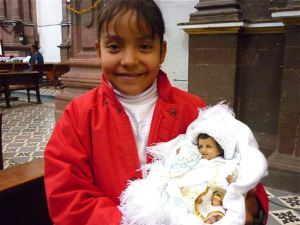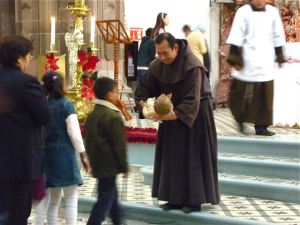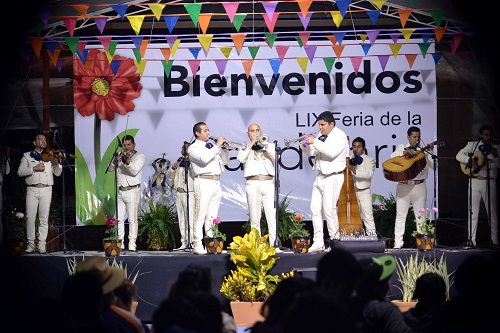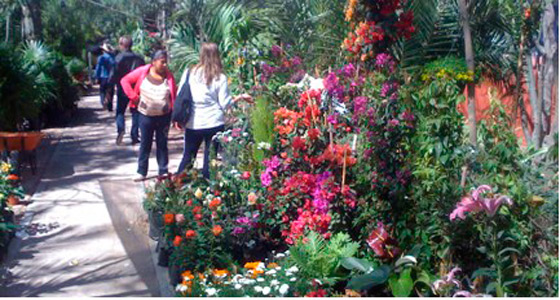Candelaria, groundhog day for our Northern neighbors, is celebrated the fortieth day after Christ’s birth on February second. Back in Jesus’ day a new mother had to wait forty days after childbirth to reenter the temple. Today the event is celebrated as the first time Jesus goes to church. Baby dolls of Jesus are removed from their nativity set and taken to the church to be blessed and kissed by the priest. Every family has at least one baby Jesus, and there are hundreds of handmade outfits available to dress your baby Jesus in.
The first year the doll is presented he is dressed in white. He dons a colored outfit of your choice for the second year. On the third year Jesus is dressed as King of the World, complete with a crown and throne ready to provide miracles.
In Pre-Hispanic San Miguel de Allende this was the time for rituals to bring rain and plentiful crops. By the seventeenth century indigenous communities brought seeds and bulbs to the churches for special blessings bringing a good harvest and the rains of April and May (now normally dry months).
For over six decades in Parque Jaurez the spring flower and garden show begins with Candelaria. Dozens of vendors line the walkways of the park, selling everything imaginable for the garden while there is music, food and dancing among the breathtaking flowering plants. Doing danzon at Candelaria is a yearly treat for me!
If, on Three King’s Day, you received the hidden baby in the special bread representing Jesus hiding from King Herod’s wrath, you host the Candelaria party on February second. The party features a mix of indigenous and Catholic beliefs with atole (a corn based drink) and tamales. Tamales, for the indigenous, represented as the beginning of life since the gods made early man from corn. Upon the arrival of the Spanish tamales came to represent Baby Jesus and why you keep the leaves on as blankets to keep the baby warm.
Candelaria came from the word candlemas from when the northern Europeans had mass by candle light to dispel the darkness of winter. Since we are farther south and warmer, Candelaria marks the beginning of Spring. The candles used on Candelaria signify dismissing the cold, awakening the earth and casting out flooding and earthquakes. The candles are also blessed today then lit to guide lost souls to heaven, part of the traditions started in honor of Tlaloc, the indigenous’ God of Rain, that was celebrated this same day.
Candelaria marks the end of the holiday season and the beginning of Spring so go enjoy the plant show and get ready for the heat!
Joseph Toone is the Historical Society’s short-story award winning author of the SMA Secrets book series. All books in the series are Amazon bestsellers in Mexican Travel and Holidays. Toone is SMA’s expert and TripAdvisor’s top ranked historical tour guide telling the stories behind what we do in today’s SMA. Visit HistoryAndCultureWalkin




